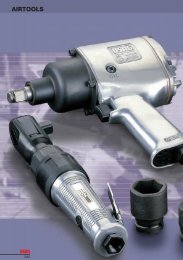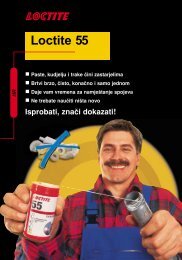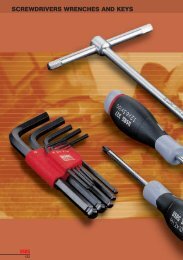Industrial seal self study guide - SKF.com
Industrial seal self study guide - SKF.com
Industrial seal self study guide - SKF.com
Create successful ePaper yourself
Turn your PDF publications into a flip-book with our unique Google optimized e-Paper software.
Troubleshooting (cont...)<br />
Pressure Blow-Out<br />
Another visible <strong>seal</strong> problem is a ruptured or inverted <strong>seal</strong> lip. Either<br />
problem results in lip leakage (fig. 9n).<br />
Causes<br />
Pressures exceeding <strong>seal</strong> design limitations can cause <strong>seal</strong> rupture,<br />
inverted lips and resultant lip leakage.<br />
Too much pressure can<br />
rupture the <strong>seal</strong> lip (fig. 9n).<br />
Extreme lip wear (B) is a sign of<br />
excess pressure. Note the lip with<br />
pressure (A) (fig. 9o).<br />
Corrective Actions<br />
Check the <strong>seal</strong> cavity for excess pressure. Provide vents to reduce pressure,<br />
or use a <strong>seal</strong> designed for high pressure applications (CRWA5).<br />
Pressure Lip Wear<br />
Signs of excessive pressure include extreme lip wear and lip leakage.<br />
Causes<br />
Excess pressure can crush the lip against the shaft. Heavy friction will<br />
eventually force the garter spring through the lip. Excess pressure can<br />
blow the lip <strong>com</strong>pletely off (Fig. 9o).<br />
Corrective Actions<br />
We re<strong>com</strong>mend two ways to prevent <strong>seal</strong> failure caused by excessive<br />
pressure. First, check the air vents to be sure they are clean. If not<br />
open them to reduce pressure. Dirt or paint may block proper air flow.<br />
Second, if the system is clean, try using a medium pressure <strong>seal</strong> such<br />
as the CRW5 and CRWA5. Make sure the system operating parameters<br />
are within the <strong>seal</strong>’s capability.<br />
84<br />
Chemical swelling<br />
In<strong>com</strong>patibility between the lip<br />
material and the operating media,<br />
including lubricants, can produce<br />
major swelling of the <strong>seal</strong> material.<br />
Above is a before (1) and after (2)<br />
example of the gross damage<br />
you may see from chemical<br />
in<strong>com</strong>patibility.(fig. 9p).<br />
Chemical Swelling<br />
A swollen, distorted appearance of the <strong>seal</strong> rubber element <strong>com</strong>bined<br />
with a “soft” feel can indicate in<strong>com</strong>patibility between the lip <strong>com</strong>pound<br />
and the media being retained or excluded.<br />
Causes<br />
The rubber is experiencing swell, an increase in volume resulting from<br />
the <strong>com</strong>pound absorbing the attacking media. This displacement of the<br />
rubber molecular structure reduces the physical strength of the rubber<br />
leading to rapid wear and failure. In extreme cases, the rubber may<br />
dissolve <strong>com</strong>pletely. With some <strong>com</strong>pounds, heat or other agents can<br />
also be responsible.<br />
Corrective Actions<br />
Consult <strong>seal</strong> catalogs and investigate to make sure that the selected<br />
<strong>seal</strong> <strong>com</strong>pound is acceptable for the media and operating conditions.<br />
Sometimes a rubber type can be sensitive to a particular media but<br />
still be adequate in the expected application but in other cases it can<br />
be ruined.







